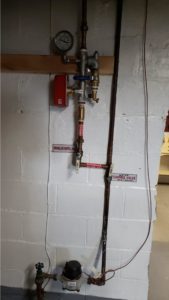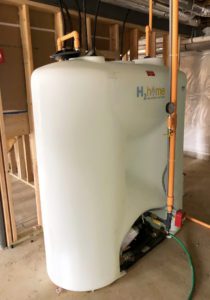Inspection Testing and Maintenance for Homeowners

In this feature NFSA’s Codes and Standards team discusses how to inspect a home fire sprinkler system. As always, contact the NFSA or a local fire sprinkler contractor for more information.
A home fire occurs every 90 seconds. There are 363,000 fires in home structures each year which lead to about 2,720 civilian deaths in homes. Residential fire sprinklers are very effective when installed and properly maintained. Installation of these systems is imperative and often once a sprinkler system is installed into a home, its maintenance is equally important.
Homeowners want to maintain them, but they simply are unaware that they should, but also that they do not know what should be done. When a new home is purchased, operation manuals for everything from the refrigerator to the trash compactor are provided, but what is provided when a sprinkler system is installed?

A home fire sprinkler system.
NFPA 13D is the Standard for The Installation of Sprinkler Systems in One- and Two-Family Dwellings and Manufactured Homes. This document provides requirements for the installation of residential sprinkler systems. Chapter 12 of this document outlines the requirements for inspection, testing, and maintenance (ITM) of these systems.
This chapter does not provide much detail other than the system shall be maintained and that the installing contractor is responsible for providing the owner or occupant instructions on how to maintain their system. NFPA 13D annex section A.12.2 provides the homeowner with some guidance on how to maintain their system such as.
- Monthly inspection of valves
- Monthly inspection of tanks
- Monthly testing of pumps
- Testing of waterflow devices every six months
- Visual inspections of the sprinklers
- Inspection of the systems by qualified individuals when ownership changes
Whether these systems are installed either by regulation or voluntarily often they are left to sit dormant. The leading reason for sprinkler system failure is a closed control valve. Shutting off the valve to the fire sprinkler systems stops the fire sprinkler system from performing. Little effort is required to verify that if a valve is open and NFPA 13D provides some installation requirements to help prevent a closed control valve.
In residential systems without a public water supply or one that is not of material value, there may be a water storage tank and small pump to supply water to the sprinkler system. It is important that these pumps be exercised (monthly per NFPA 13D) regularly to ensure they will operate if needed.

A tank for a home fire sprinkler system.
How to Inspect a Home Fire Sprinkler System
For homeowners who are unsure what to do for fire sprinkler maintenance in their home, some research on the internet can assist in knowing more on their fire sprinkler system, such as https://firesprinklersbuylife.com/upkeep or https://homefiresprinkler.org/its-easy-to-live-with-home-fire-sprinklers-2/. Qualified and licensed contractors can be found online as well as at the NFSA website https://member.nfsa.org/Directories/Contractor-Directory.
Many homeowners know there is required maintenance on heating and air conditioning units as well as other systems in the home and have little hesitation about contacting a contractor to service these systems at least annually however, the fire sprinkler system which is typically right next to the HVAC unit or hot water heater can often go unnoticed.
There is not much to periodically conducting ITM for a home fire sprinkler system. A home is one of if not the largest investment many will make in their lifetimes. Sprinklers can help protect these investments and loved ones. It is a good feeling to be proud of our homes and to want all the best stuff, but to ensure the home investment and loved ones are safer sprinkler systems should be installed all homes and of course periodically maintained.
HAVE A QUESTION ABOUT INSPECTING A RESIDENTIAL FIRE SPRINKLER SYSTEM? CONTACT THE NFSA TODAY
Members and employees of NFSA work very closely in the codes and standards development process. Our team of experts stay on the cutting edge of fire protection issues by participating in over 250 codes and standards development committees. If you have an interest in NFSA’s mission to protect lives and property through the widespread acceptance of the fire sprinkler concept, or you simply want to get more involved in the codes and standards process with NFSA, please visit our membership page.
